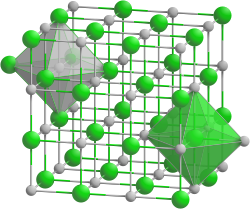Lead polonid
| Crystal structure | ||||||||||
|---|---|---|---|---|---|---|---|---|---|---|

|
||||||||||
| __ Pb 2+ __ Po 2− | ||||||||||
| Crystal system | ||||||||||
| Space group |
Fm 3 m (No. 225) |
|||||||||
| Lattice parameters |
a = 6.59 Å |
|||||||||
| General | ||||||||||
| Surname | Lead polonid | |||||||||
| other names |
Lead (II) polonide |
|||||||||
| Ratio formula | PbPo | |||||||||
| External identifiers / databases | ||||||||||
|
||||||||||
| properties | ||||||||||
| Molar mass | 416.20 g mol −1 | |||||||||
| Physical state |
firmly |
|||||||||
| density |
9.64 g cm −3 |
|||||||||
| Melting point |
decomposes at 550–630 ° C |
|||||||||
| Hazard and safety information | ||||||||||
 Radioactive |
||||||||||
|
||||||||||
| As far as possible and customary, SI units are used. Unless otherwise noted, the data given apply to standard conditions . | ||||||||||
Lead polonide , PbPo is a chemical compound of lead from the group of polonides .
Extraction and presentation
The connection can be made by introducing polonium vapors into molten lead under vacuum .
properties
Bleipolonid crystallized analogously to lead telluride in the sodium chloride structure , a cubic crystal system . It has the space group Fm 3 m (space group no. 225) and the lattice parameter a = 6.59 Å .
Individual evidence
- ↑ Harvey V. Moyer: Chemical Properties of Polonium . 1956, p. 96 , doi : 10.2172 / 4367751 .
- ↑ Terumitsu Miura, Toru Obara, Hiroshi Sekimoto: Experimental verification of thermal decomposition of lead polonide . In: Annals of Nuclear Energy . November 2007, p. 926-930 , doi : 10.1016 / j.anucene.2007.05.009 .
- ↑ The hazards emanating from radioactivity do not belong to the properties to be classified according to the GHS labeling. With regard to other hazards, this substance has either not yet been classified or a reliable and citable source has not yet been found.
- ^ AP Hagen: Inorganic Reactions and Methods, The Formation of Bonds to Group VIB (O, S, Se, Te, Po) Elements . John Wiley & Sons, 2009, ISBN 0-470-14540-4 , pp. 161 .
- ↑ Richard Dalven: Recent Studies Of Lead Polonide (PBPO) . Lawrence Berkeley National Laboratory, December 1973. ( Link )